This yummy toddler smoothie method is simple to blend up and even easier to customize for breakfast or snack time. It’s a perfect smoothie for kids since it’s naturally sweet, loaded with nutrition from fruit and veggies, and tastes great! Plus: The one master recipe can be made 10 easy ways.
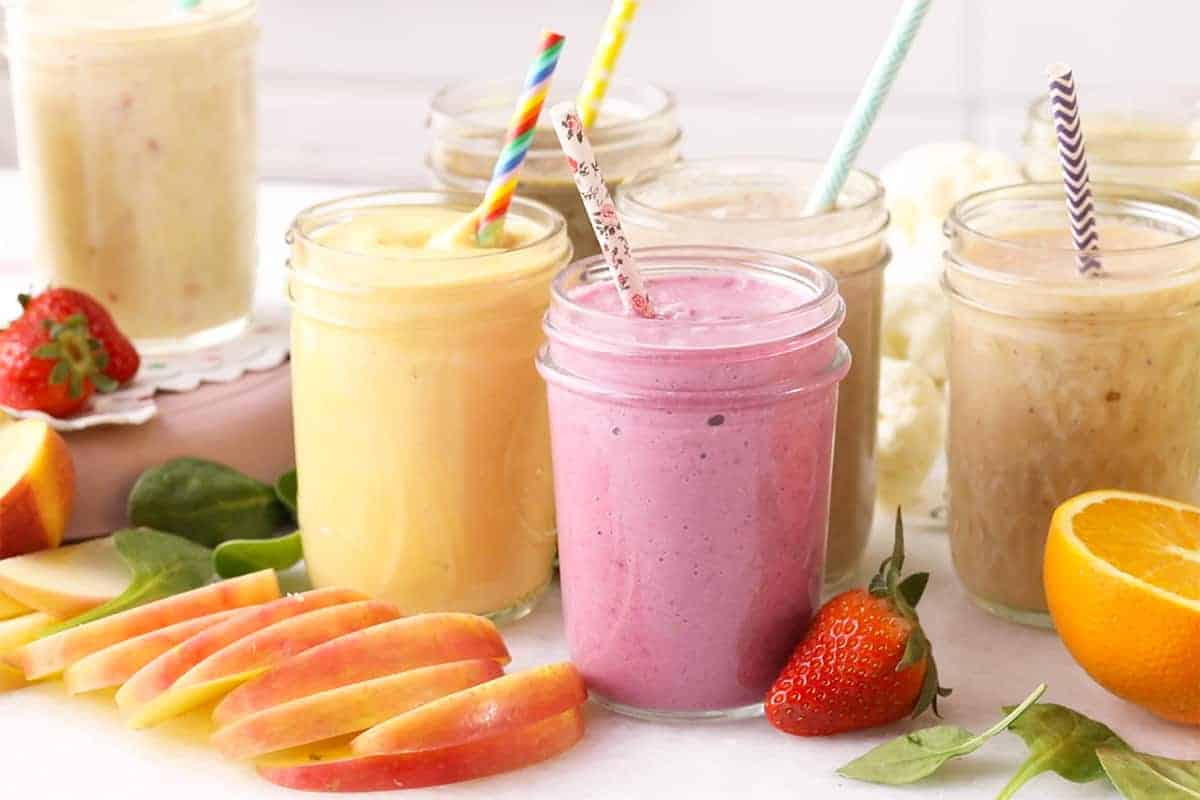
Healthy Toddler Smoothies
One of the best ways to help your toddler and older kids eat more fruits and vegetables is to pack them into smoothies. By starting with one master smoothie recipe and varying it based on what your kids like (and for any food allergy concerns), you can increase the likelihood that they will actually drink it—which is clearly key!
This recipe is flexible and versatile.
To be completely honest, my oldest has never been a fan of smoothies. Because of that, I tried very hard to get my second and third kids to like them right from the start. I make them smoothies a few times a week so they are familiar and I’m happy to report that she’s a total fan.
We love smoothies for healthy breakfasts and snacks. And it’s nice that you can keep almost all of the ingredients on hand in the freezer or pantry.

Smoothies for Kids
One of my best tips for helping kids like smoothies is to avoid packing them too full of extras. Because if you go overboard on veggies and things like chia seeds, a kid smoothie can taste like sludge really fast. But thankfully, you can still make a healthy smoothie that’s packed with nutrition if you know how to balance the ingredients.
TIP: If your toddler regularly drinks milk at breakfast, try switching to smoothies some days. This has the benefit of allowing you to fill their bellies with a range of nutrition and flavors.
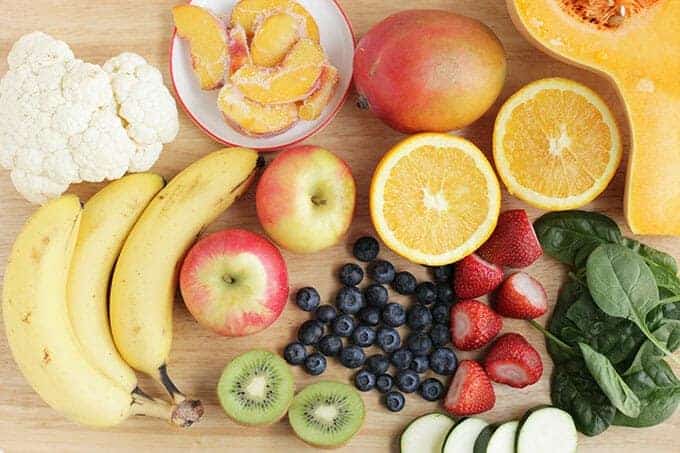
Ingredients You Need
There’s one master recipe here, but you can pick which fruits and veggies to use so you can customize it for your child.
Generally you’ll need:
- Milk (I prefer non-dairy)
- Fruit
- Veggie
- Frozen banana
- Optional add-ins
TIP: I like to do half frozen fruit and half fresh fruit to avoid having a smoothie that’s a nice and easy thickness for toddlers to drink.
Step-by-Step Instructions
Here’s a look at the process involved in making smoothies for kids. Scroll down to the bottom of the post for all of the recipes.
- Add the milk to the blender. (We prefer nondairy milks since they seem to have a slightly better consistency and less of a tendency to separate after blending.)
- Add the fruit and veggie.
- Add any optional ingredients.
- Blend the smoothie really well to ensure that it has a very creamy texture.
- Serve it in a reusable pouch, a small open cup, or in a sippy cup depending on what your kid likes best.
TIP: To help ensure a good texture and flavor in our veggie smoothies, we pick just a few ingredients each time and keep the flavors simple.
Smoothies for Toddlers with Food Allergies
If your toddler has food allergies, it’s easy to adjust a smoothie for them. If they are allergic to bananas, use 2 tablespoons avocado instead or try a teaspoon or two of nut butter. Use whichever type of milk you prefer—almond, flax, coconut, rice, dairy, or even kefir.
We tend to use Silk Protein Nut Milk, Ripple Milk, or New Karma Flaxmilk in our smoothies.
Kid-Friendly Constipation Smoothie
If your toddler has frequent constipation or a sudden bout, a smoothie with hidden veggies can help. Consider adding chia seeds or hemp seeds, and a small spoonful of coconut oil, flaxseed oil, or avocado. You can also use full-fat coconut milk as the base.
The healthy fats can coat the digestive tract, making it easier for food waste to pass through. And, since the foods in toddler smoothies are already blended, it’s much less work for their digestive systems!
TIP: This is my best Constipation Smoothie recipe.
Smoothies for Toddlers to Gain Weight
If your doctor has told you that your toddler needs to gain weight, a smoothie can be a helpful mealtime tool. Consider adding nut butters, avocado, healthy oils (flax, fish), full fat yogurt, hemp seeds, and offering a serving of a toddler smoothie at snack time, mealtime, or as a bedtime snack.
Use those in between times to get in a little extra nutrition and calories (though remember that we can’t impact how hungry our kids feel).
TIP: Find more foods to help toddlers gain weight here.
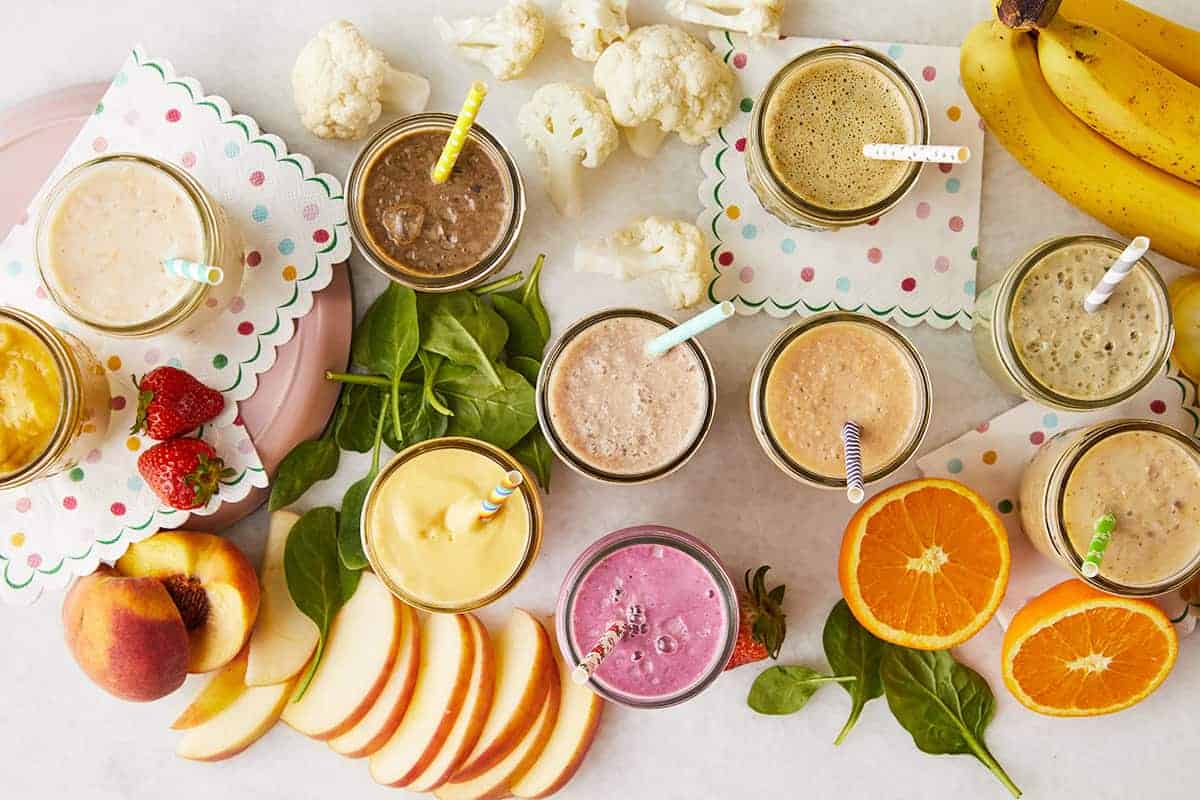
Frequently Asked Questions
After a baby is eating solid foods, they can start smoothies almost right away. Avoid using sweetened milks and opt for a plain unsweetened nondairy milk instead. And serve on a spoon, in a very small open cup or in a reusable pouch. (You just don’t want to substitute it for breastmilk or formula.)
If you have a kid who won’t eat many vegetables, veggie smoothies can be a great option since the veggies are served in a slightly sweet drink that tastes like a milkshake. Resist the urge to add more of any vegetable than my recipe below because that may impact the flavor or texture. And be sure to blend them very, very well.
And try some of the combinations below that aren’t green first, since pink, orange, purple, or even white smoothies are often much less alarming than green ones. Then, once you have a smoothie fan, try offering a green one!
Frozen banana and mango make smoothies very smooth and creamy. Then you can add in almost any other fruit to make a delicious flavor combination
You can add hemp seeds, chia seeds, yogurt, avocado, fish oil, and/or nut or seed butters in small amounts to smoothies.
(I don’t add things like bee pollen or collagen or protein powder because while I know that some swear by these types of smoothie boosts, I find them to be expensive and not very accessible for most people. If you like them or want to try them, by all means, go for it!)
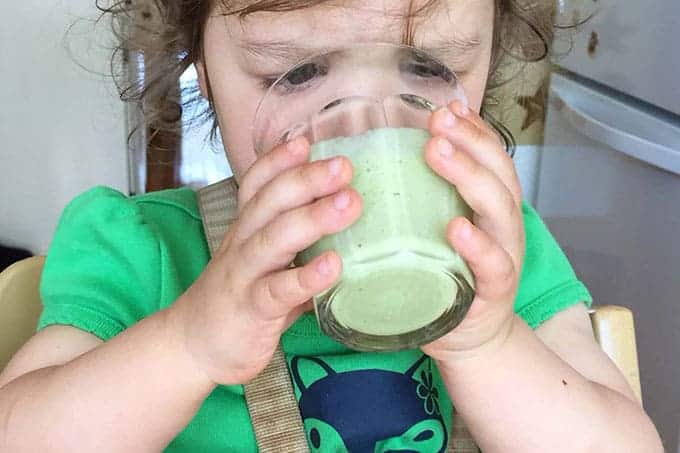
Best Tips for Success
Here are some tips to consider when making a fruit and veggie smoothie for your kids.
- If you can freeze the greens ahead of time, the finished product will taste much less “green” but will have the same nutrition. Just make sure the greens are dry, then put them into a zip top freezer bag and store in the freezer for up to 3 months.
- Blend really (really!) well to get a very smooth consistency, adding a little more milk (or even water) as needed to thin.
- You can get a less thick texture in toddler smoothies, which some kids prefer by using fresh fruit rather than frozen—and this is also a good option for winter days when a frozen drink is less than ideal.
- You can use yogurt in place of milk if you add a fruit with a lot of liquid like a clementine or orange.
- Try using half milk and half yogurt for a creamier texture some toddlers may prefer.
- Serve toddler smoothies in a reusable pouch (we like Squeasy Gear!) or in a cup with a straw.
- You can also offer small tastes with a spoon if you have a child who isn’t yet a fan. Consider even a small sampling a success!
- Sprinkle on some granola or a favorite cereal and serve as a smoothie bowl for a fun variation.
- And if nothing else works, freeze them into popsicles!
I’d love to know if you’ve tried this recipe and what your family thinks of it so please rate and comment below!
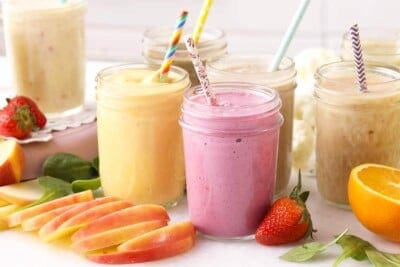
Favorite Healthy Toddler Smoothie (with Veggies!)
Ingredients
- 1 cup milk (I prefer nondairy)
- 1 small banana (fresh or frozen)
- 1/2 cup fresh or frozen fruit (such as blueberries, strawberries, mango, apple, or kiwi)
- 1/2 cup veggies (such as kale, spinach, raw fresh or frozen chopped cauliflower, raw fresh or frozen sliced zucchini, raw fresh or frozen sliced summer squash, roasted sweet potato, roasted butternut squash, steamed diced beets)
- Optional add ins (pick 1-2: 1 teaspoon hemp seeds, chia seeds, or ground flaxseed 1 tablespoon nut butter 2 tablespoons avocado 1-2 teaspoons cocoa powder 1-2 teaspoons honey or maple syrup 1 tablespoon rolled oats)
Instructions
- Add chosen ingredients to a blender.
- Blend until very smooth, stopping to scrape down the sides of the bowl and adding more liquid if needed.
- Serve immediately.
Equipment
Notes
- Blueberry Cocoa: Milk, banana, blueberries, spinach, cocoa powder
- Strawberry Banana: Milk, banana, strawberries, raw cauliflower, hemp seeds
- Mango Coconut Sweet Potato: Coconut milk, avocado, mango, sweet potato (cooked and cooled)
- Honey Peach: Milk, banana, peaches, raw summer squash, flaxseed
- Creamsicle: Yogurt, banana, orange, butternut squash (cooked and cooled)
- Tropical Greens: Milk, banana, kiwi, kale, chia seeds
- Cocoa Banana: Milk, banana (1 whole), spinach, cocoa powder, nut butter
- Tangy Peach: Kefir (instead of milk), banana, peach, honey, raw cauliflower
- Cinnamon Apple: Milk, banana, apple, raw summer squash, dash cinnamon
- Strawberry Beet: Milk, avocado, strawberries, raw beets (or leftover cooked), maple syrup
- If you can freeze the greens ahead of time, the finished product will taste much less “green” but will have the same nutrition. Just make sure the greens are dry, then put them into a zip top freezer bag and store in the freezer for up to 3 months.
- You can use raw cauliflower, zucchini, beets, and summer squash. (Or you can freeze those raw veggies and add them frozen.)
- You can add fully cooked and cooled sweet potato, butternut squash, and beets. (Any kind work, even leftover puree, as long as it’s not seasoned or salted.)
- Blend really (really!) well to get a very smooth consistency, adding a little more milk (or even water) as needed to thin.
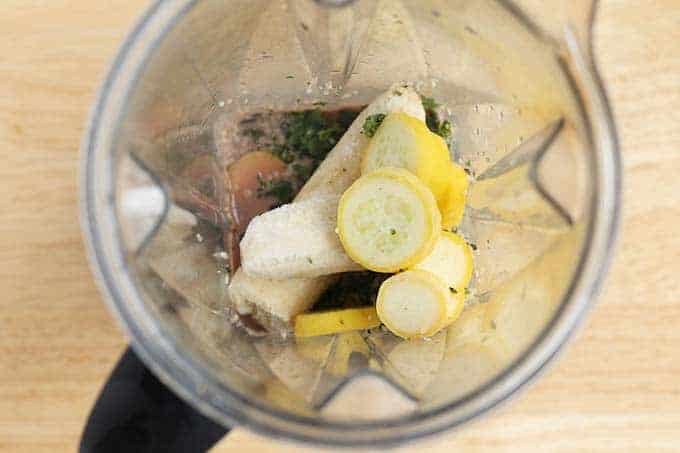
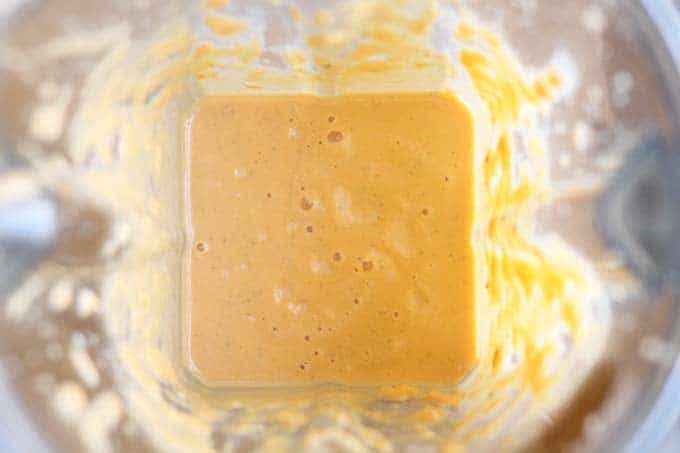
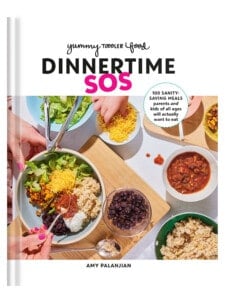
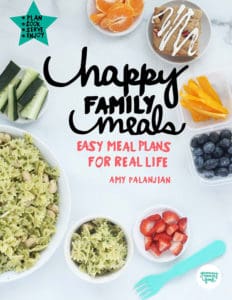
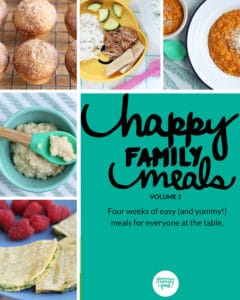
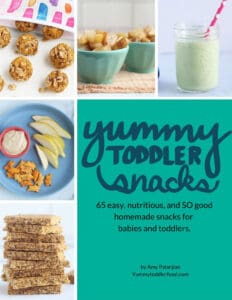














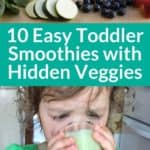
You say you prefer non-dairy milk. Would oat milk be a good milk to use in these recipes?
Sure, that will work. (Sometimes whole milk can cause the mixtures to separate with some of the fruits which is why I don’t recommend it here.)
Finally a simple recipe that my toddler likes and doesn’t call for 20 ingredients I don’t have. Thank you!
Tangy peach is insane !!!! That is literally the best smoothie I have ever had!!!!!!! Amazing that there is cauliflower in it, you are a creative genius!
So glad to hear it!
Are these smoothies thick enough to be put into a reusable pouch and be eaten from the pouch?
My toddler won’t touch any veggies except when I buy the baby smoothie pouches, but they’re tiny and cost so much!
So was thinking of batch-making lots of reusable pouches to go in the freezer – could I do this? And then do I just put it in the fridge the day before use to thaw?
(I’m worried it’s gonna have some weird separation after freezing or be too liquidy)
You don’t add ice to it?
I don’t add ice if using some frozen fruit. You can if you’d like.
Big fans of smoothies here. We frequently use blueberries and regular milk and we often freeze and thaw at a later date. My guys have been drinking them since 6-12 months though (can’t remember exact age). No complaints from anyone! Then again, we also use opaque-ish containers for serving and no one has spoken about separation or blueberries here.
Dear Amy, your recipes have been so helpful as I try to feed my son homemade, healthy nomz — thanks for sharing your knowledge!! How long would these keep in the fridge, and is it a possibility to freeze them (premade pouch)? Thank you
Yes you can freeze them. They are best within 24 hours after storing in the fridge. I usually only serve blueberry immediately though since it can separate while sitting.
How do we go about cooking to sweet potatoes and any other things for these smoothies?
Do we just boil them?
For the sweet potatoes, you can use any method you prefer (boiling, steaming, roasting) without salt. Then just let cool before adding to the smoothie.
This is our go-to smoothie recipe that I make for my kids twice a week! Such an easy and delicious way to get Kale into their diets! I wanted to ask – would this translate well into a popsicle if put into a popsicle mold after it’s made? TIA!
For things like the frozen cauliflower, i read on the bag that you need to cook it to a safe temp before consuming. Is it safe to use uncoooked?
I recommend freezing fresh cauliflower yourself to avoid this issue.
I’ve read somewhere that using cow’s milk can curd the smoothie when it has citrus fruit, is this true? If so can I use soymilk?
It may depend on the fruit and the amounts and yes you can use soy milk.
I can’t wait to try these. My son refuses to eat fruit or veggies. But after finding some dinosaur popsicle molds (he’s obsessed with dinosaurs) I plan on making smoothie popsicles in hopes of finally finding a way to get him to eat them. Here’s to hoping they go over well when the molds arrive.
I’ve made your blueberry banana smoothie three times this week and today, I tried banana and mango and it tastes so good! The entire family loves this recipe, including our 15 month old daughter that doesn’t eat any veggies if she sees them. Thank you for sharing!
I’m so glad!
CAULIFLOWER?! Color me surprised. Doing this immediately.